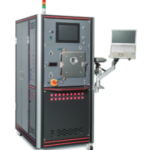
Spark Plasma Sintering (SPS): Next-gen material synthesis technology
SUGA Co., Ltd. / Sales Division
SPS (Spark Plasma Sintering) is the next-gen material synthesis technology, also well known as PECS (Pulsed Electric Current Sintering) or ECAS (Electric Current Activated / Assisted Sintering) which was established in the latter half of 1990s and began to be developed in 2000s.
The history of SPS is relatively short compared to the conventional powder metallurgy method like hot press method that started around 1930 or HIP from 1960s, but it has been dramatically evolved as the advanced material synthesis technology to apply ultra high pressure regions and high speed (in seconds) synthesis that was difficult or impossible with the conventional sintering method.
The conventional sintering methods in general, heat the sample with an external heater, etc., whereas SPS raises the temperature by Joule heating created by applying an electric current through the sample or the mold filled with the sample. By using the pulsed current, SPS can raise the temperature much faster which is not possible with the conventional sintering methods. As a result, this new technology is attracting the attention of material researchers and engineers, and many papers have been published on improving the thermoelectric properties, magnetic properties, tensile strength, hardness, pitting force, etc.
SPS can provide high quality sintered compact with high-performance which has never been successful in conventional sintering methods.
The concept of SPS is originated by Japanese researcher and it has been promoted by Japanese companies who have taken initiative in its business to apply pulsed current. In addition to the conventional sintering driving force of “heat” and “pressurization”, SPS with this pulsed current, gets the peculiar influence and effect from the electrical energy of the electromagnetic field and the plasma phenomenon at the time of discharge between powder particles which are believed as the key factor to enhance the quality and performance of the sintered compact. Since the mechanism of SPS is still not fully investigated, many researches have been conducted to clarify what is really happening during SPS process and what causes a superior outcome.
The various effects of pulse energization such as acceleration of mass transfer by electromagnetic field, temperature rise by heat of spark plasma, rapid temperature rise and rapid cooling by ON / OFF pulse effect, etc. have been examined and discussed, and research including verification test has been conducted.
In these circumstances, it is becoming an established theory among material researchers and physics / chemistry researchers that pulse energization has some electromagnetic energy effect on SPS although we have not come to the absolute conclusion with the evidence.
SPS is drawing unremarkable attention as the new generation of material synthesis technology which will continue to evolve in the future even though it includes unknown areas. At the next column, we will discuss the potentialities and advantages as well as disadvantages and assignments of SPS.




